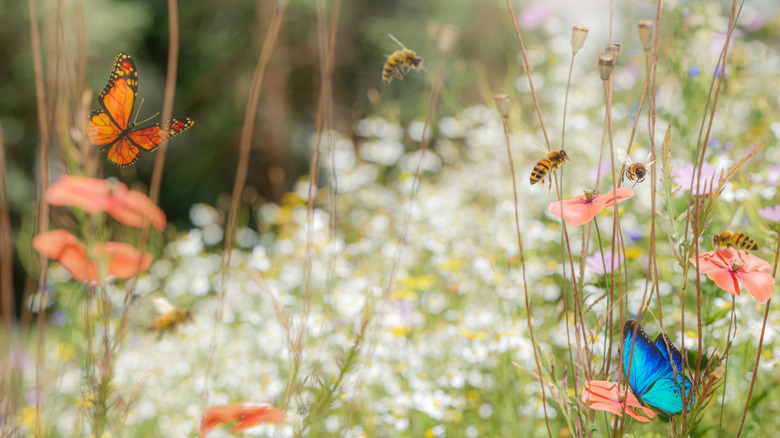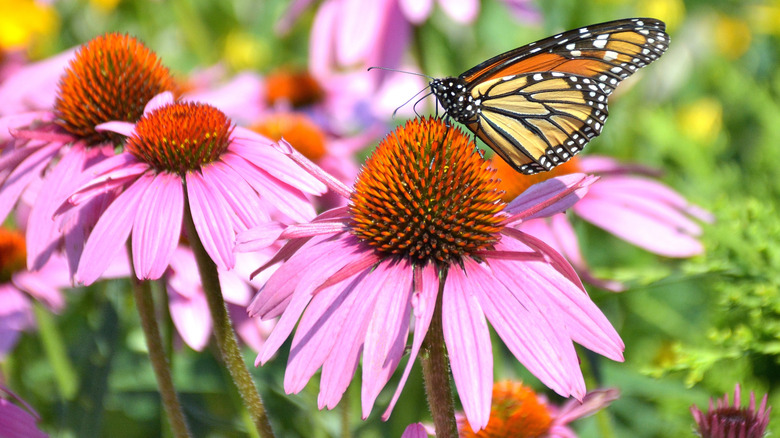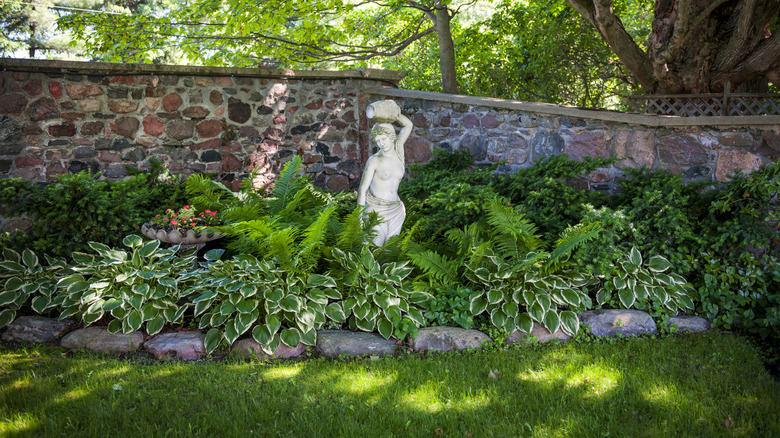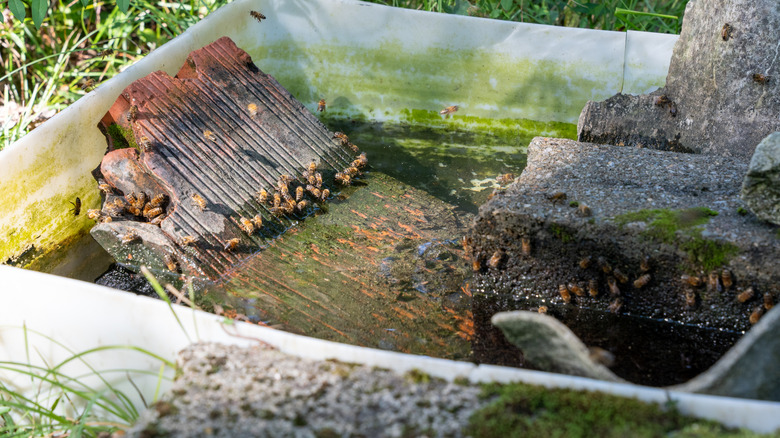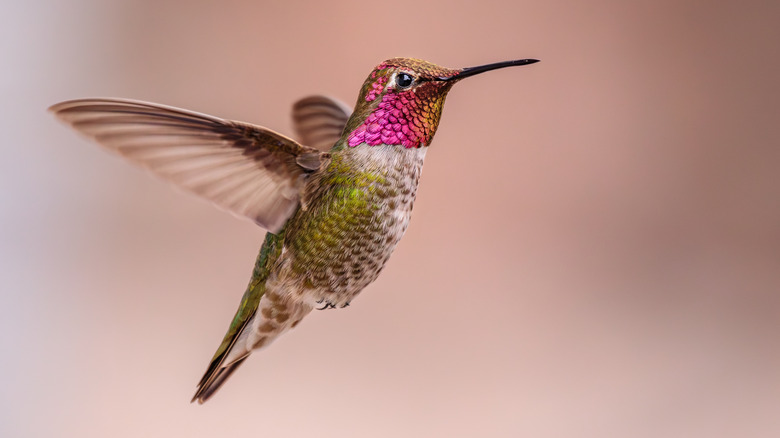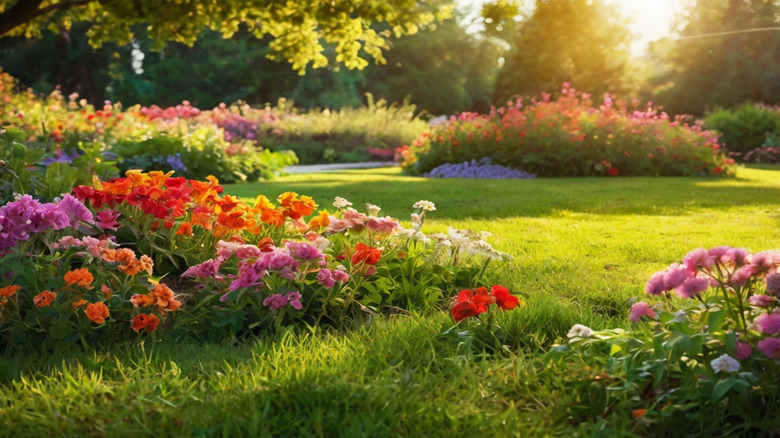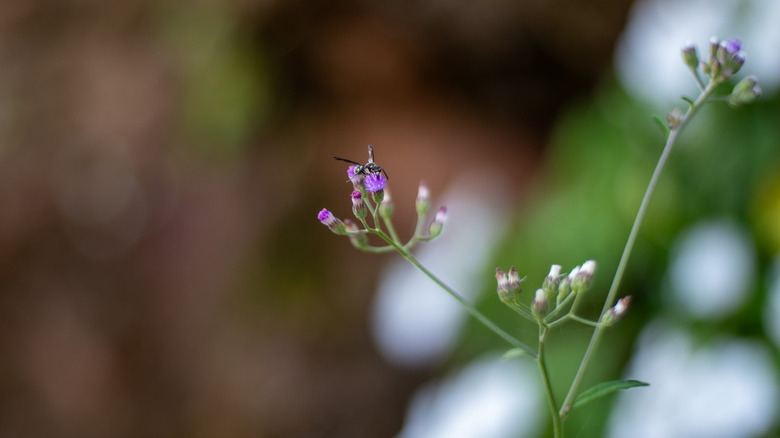14 Reasons That Pollinators Aren't Coming To Your Garden
Many people think that all you need to do to bring more pollinators to your garden is plant a few colorful flowers. While that can attract some, it likely won't give you the results you're looking for. There are hundreds of thousands of pollinating insects and animals, each with its own specific needs when it comes to food, shelter, and nesting sites. Even if they're missing just one resource, it may be enough for them to look elsewhere. Not only is it disappointing not to see as many as you'd like, but with pollinators facing increasing threats from habitat loss, climate shifts, and other stressors, it's more important than ever to do what we can to help.
Sometimes, all it takes is a small tweak to make your yard a pollinator hot spot again. On the other hand, it could be due to environmental factors outside of your control. If your garden hasn't been buzzing with visitors or you've noticed a decrease in activity, the reasons below can help you narrow down what might be keeping them away.
Your garden doesn't have enough nectar-rich flowers
Even if your garden is filled with beautiful blooms, pollinators are unlikely to be interested if flowers aren't nectar-rich. Nectar is a pollinator's main food source, giving them the energy they need to survive. If your flowers are nutrient-poor, they have little reason to continue visiting your yard. Some of the most common flowering plants, like certain begonia varieties, are bred for their looks rather than their nectar content. So, although they may look fabulous in the garden, they won't serve much of a purpose to the bees and butterflies.
Next time you head to a garden center or order flower seeds, make sure you're choosing varieties that are rich in nectar. If you're serious about attracting pollinators, opt for primarily native plants. According to The Center for Pollinator Research, native plants are four times more attractive to pollinators and tend to be more nectar-rich than non-natives. A great option for attracting butterflies, bees, and hummingbirds is wild bergamot (Monarda fistulosa), which puts out shaggy, purple blooms from summer to fall. Purple coneflower (Echinacea purpurea), spotted Joe Pye weed (Eutrochium maculatum), ninebark (Physocarpus opulifolius), and figwort (Scrophularia marilandica) are some other considerable choices with attractive flowers and nutritional benefits for our small garden visitors.
Your flowering plants aren't the right color for attracting your favorite pollinators
While nectar-rich flowers are key to encouraging pollinators to return, it's often color that attracts them in the first place. Over millions of years, flowering plants have evolved to produce bright colors that lure in bees, butterflies, and other beneficial insects. Because each species perceives color differently, some shades stand out more than others. Understanding each pollinator's unique range of color vision can help you better attract the visitors you want to see more of.
One of the easiest pollinators to attract with color is butterflies, which can see color variations that we don't even pick up on. Bright reds, oranges, yellows, pinks, and purples all work well to attract butterflies to your garden. Bees also have impressive eyesight, and their eyes see colors much more quickly than we do. They can't see red, but they're highly sensitive to blue, green, and ultraviolet light. So, to have more bees buzzing around your yard, you'll want lots of purple, violet, and blue blooms.
Interestingly, scientists once believed that red flowers evolved to attract hummingbirds, but newer research suggests they actually developed those hues to deter bees. That said, the bright reds and pinks that bees ignore are exactly what catch a hummingbird's eye. Unlike bees, hummingbirds have unique color receptors that make blue shades appear dull, but make warm hues like reds and yellows more vibrant.
The flowers in your garden aren't suited for certain pollinators' feeding styles
Just as color grabs the attention of certain pollinators, the shapes and textures of flowers can draw them in. Each insect and animal has a different feeding style, so flowers provide pollinators with visual cues that signify they're suitable to drink from. The key to attracting your desired pollinators is choosing flowers with colors and shapes that suit them. For example, if you have a shrub with bright red blooms to attract hummingbirds, they likely won't stick around if the overall structure makes it impossible for them to access the nectar.
If pollinators aren't visiting, you may not have enough flowers that are easy for them to drink from. Hummingbirds have long tongues and beaks, so they prefer tubular blooms that make it easy for them to get to the nectar. Similarly, butterflies have a long, tongue-like proboscis that uncoils to reach into flowers and feed. While they can drink from a variety of flowers, they prefer those that are large and open, as they provide an area for them to land on as they drink. As for bees, there are short- and long-tongued species, so each type will be most attracted to what's easiest for them to access food. Short-tongued bees typically prefer flat-topped flowers with nectar closer to the surface, while long-tongued bees can drink from deeper blooms.
Gaps in bloom times are leaving pollinators hungry
If your flowers are bursting to life in spring but are gone by summer, you'll likely notice a drop in visits. Without a steady supply of nectar, they won't just take a break from stopping by, but they may even consider your yard to be an unreliable place to feed. Many pollinators, including hummingbirds and some butterfly species, have surprisingly good memories. Over time, they learn where the good spots are and will naturally be drawn to gardens that always have constant access to their resources.
When planning your pollinator garden, make sure to choose a variety of flowering species that bloom throughout the year. It's toughest for pollinators to find nectar in early spring and late fall, so providing food during these slower seasons will make your yard even more memorable. Ideally, add plants that attract multiple types of pollinators each month so you don't wind up with flowers that only suit hummingbirds in spring and butterflies in summer. Additionally, plan accordingly to avoid having isolated blooms scattered throughout the yard. Group flowers together with similar bloom times, as pollinators can spot clusters of bright colors from farther away.
There aren't any nesting spots in your garden
Although most pollinators can travel long distances, many prefer to forage close to their nests to save time and energy. Without suitable nesting areas, they may stop by your garden in a pinch, but they likely won't have any reason to make it their home base. Additionally, supporting their nesting habits means you're helping them continue their life cycles. As their young mature, you'll have even more beneficial insects in your garden with each passing year.
If your yard is over-manicured, pollinators may struggle to find nesting areas. Ground-nesting bees, for example, need small patches of bare, undisturbed soil, while others prefer hollow stems or cavities in old wood. You can also hang a bee hotel or keep dead flower stalks standing through winter. Hummingbirds build their nests in shrubs or small deciduous trees near nectar-rich flowers and other food sources. Leave nest-building materials, like spider webs, twigs, and moss, to further encourage them to nest in your yard. Plants with soft fibers, like thistle, also provide excellent downy material that hummingbirds love to line their nests with.
Your yard doesn't provide them with habitat
Most of our beloved beneficial insects are tiny and require safe spaces to retreat to when avoiding predators or harsh weather. Pollinators like bees, fireflies, and moths seek shelter in what we typically think of as the messiest parts of your yard, like brush piles, leaves, or dead plants. If they don't have these natural areas to shelter or overwinter in, they won't just avoid your yard; they may also struggle to survive the season and continue their life cycles. Creating safe spaces for them to rest and take cover makes it easier for them to survive throughout the seasons and encourages them to return.
One of the best things you can do to support pollinators and other wildlife is to leave a part of your yard a little wild. Luckily, this means you have to do less work, not more. You can either leave a layer of leaves over the ground, rake them into a pile off to the side of your property, or add them to an empty garden bed. Add in fallen branches or dead wood to build a brush pile, and let the grass grow a bit taller in your little pollinator corner.
Your garden lacks a balance of sun, shade, and wind protection
One reason pollinators may not be visiting your garden is that it doesn't offer a balance of sunny, open spaces and more sheltered areas. Some insects, like butterflies, prefer open, sunny spots when foraging, but they also need protective shade for scorching hot summer days. It's also important to remember that most pollinators are much smaller than we are. What may feel like a light breeze to us can feel like a full-on windstorm to them. So, if they're attempting to make it to your yard, only to be hit by a gust of wind, they may retreat to a safer, more protected area.
If most of your plants are in the sun, consider growing a gorgeous, healthy shade garden. Growing flowering plants in multiple light conditions helps to round out your space so pollinators have open feeding spots and calmer areas to relax. Just like they need protection from the sun, make sure they can travel safely without navigating harsh, unprotected winds. Add some kind of windbreak in your garden, whether it's a line of trees, a fence, or another structure.
You don't have host plants for butterflies
To reproduce successfully, butterflies require specific plant families or species, known as host plants. Female butterflies use receptors on their feet to taste the leaves, indicating they've found the right plant to lay eggs on. Once the caterpillars emerge, they'll only eat the foliage of that particular plant. So, while nectar-rich flowers bring adult butterflies to your garden, adding plants for their young is what supports future generations and keeps them coming back year after year.
There are several host plants that will fill your garden with a variety of butterflies, and it's an easy way to attract your favorite species. For example, monarch caterpillars can only eat milkweeds (Asclepias spp.), so adding a few to your garden gives you the best chance of spotting this beloved butterfly. Others, like the silvery checkerspot, have several host plants, including sunflowers (Helianthus spp.), coneflowers (Echinacea spp.), and black-eyed Susans (Rudbeckia spp.). The best part is that many host plants also feed adult butterflies, so a single planting can support them from larvae to adulthood.
Pesticides are harming your local pollinators
Even if you did everything correctly to start a pollinator garden, pesticides can undo your hard work by harming the very insects or birds you're trying to attract. These harsh chemicals can drastically reduce hummingbird metabolism, potentially reducing their appetite and leaving them with too little energy to survive. They can kill smaller pollinators, like bees, butterflies, lightning bugs, and beetles, on contact and can linger on flowers, leaves, and soil long after application. In some cases, bees will carry pesticide residues back to the hive, affecting the entire colony. When used incorrectly, these chemicals can travel far beyond where they were applied. So even if you haven't used any directly in your garden, it can still be affected by pesticide drift.
Although the simplest solution is to avoid pesticide use, it isn't always practical, especially if you're dealing with an infestation. Opt for more eco-friendly alternatives, particularly those that degrade rapidly, when possible. Only treat your plants in the evening, when beneficial insects are the least active. Avoid using aerial applications anywhere in your yard to prevent pesticide drift. Instead, choose granular formulations or soil treatments that can better target a specific area.
The weather is keeping pollinators in hiding
Nobody wants to venture out in the rain, least of all a creature only slightly larger than a raindrop. It can be risky for them to fly during rain or hailstorms, so they avoid traveling during these times. Heavy storms can also flood underground bee nests, and temperatures can drop, which makes it difficult for butterflies to safely continue their flight. Once your local pollinators begin to sense a change in the weather, they'll quickly look for the safest place to take cover until the storm passes. So, if it's been stormy or cold in your area, there's a good chance the pollinators are temporarily hiding nearby.
Creating an environment where pollinators can feel safe — whether rain or shine — will make your garden even more attractive to them. This is another reason why keeping part of your pollinator garden a little unkempt and natural will make the birds and insects feel right at home. Tall grasses, dense shrubs, and broad, leafy trees all provide safe shelters for them to wait out the storm.
Thirsty pollinators can't find water in your garden
Just like we don't get all of our water from food, most pollinators will need more than nectar to stay hydrated throughout the day. In addition to quenching their thirst, some bee species require water to regulate the hive's temperature and humidity. Butterflies and moths do what's referred to as puddling, where they get minerals and salts in addition to water in mud puddles. Although hummingbirds hydrate mostly through nectar, they'll still use water sources to clean their feathers or cool off during hot periods.
Typical water features are far too deep for most pollinators, so instead, you'll want to add a bee bath to your flower garden. First, take note of where insects or birds are most active in your garden. It may be near flowers, compost, a brush pile, or even bare soil. Place a shallow container near the area and fill it with water. Then, add a few sticks or small rocks to create landing platforms so they can drink safely without the risk of drowning. Add a moving water feature, like a fountain or mister, if you want it to be especially attractive to hummingbirds. Be sure to empty and refill it a couple of times a week to keep the water clean and prevent it from becoming a mosquito breeding site.
Pollinators haven't found your garden yet
You've done your research and planted nectar-rich flowers, provided habitat, and done everything in your power to support your local pollinators. Yet, you've barely seen any fly through. Why is that? It could be as simple as them not finding it yet. Butterflies, for example, can only see within about 100 feet, and their vision is blurrier than ours. So, even a colorful yard may not stand out to them immediately. Additionally, if your neighbors don't have pollinator-friendly gardens, they may not have had a reason to venture over your yard just yet.
If you're confident that your property has all of the resources a pollinator would need, then the best thing you can do is to keep doing what you're doing. You'll need to be patient, as it may take a few seasons before a tiny traveler finally discovers your garden. Once those first few visitors stop by and begin nesting in your area, you'll get to enjoy generations of birds and insects returning for years to come.
Your local pollinators aren't as active this year
If your pollinator garden has been a hit for years, and then you notice a sudden decline, there's a good chance it's because your local pollinators aren't as active this year. Birds, bats, bees, butterflies, fireflies, and other favorite pollinating species have been facing threats like habitat destruction, climate change, and pesticide use. These conditions can cause local populations to shrink temporarily, and fewer pollinators will make their way to your area. It's also possible they've faced a disease outbreak or weren't able to properly overwinter.
Try not to panic if your garden isn't as busy as it typically is, especially if you've had success in previous years. Providing food, water, habitat, and other resources to pollinators is one of the best ways to help them as they face environmental stressors. Fluctuations aren't completely out of the norm, and your local pollinator activity is likely to rebound once conditions stabilize.
You may not have noticed the pollinators in your garden
Although you may imagine fuzzy bumblebees, colorful butterflies, and speedy hummingbirds when thinking of pollinators, there are actually around 350,000 species worldwide. According to fossil records, flies and beetles were actually some of our first pollinating species around 150 million years ago, and they still help our plants reproduce today. Your garden is likely filled with tiny flies, small beetles, beneficial wasps, and other insects you didn't realize were busy pollinating your flowers. Additionally, even more well-known pollinating species, like bees, come in all shapes and sizes. In fact, the tiniest native bee isn't even 2 millimeters long!
The next time you're admiring your flowers, look more closely. You may notice some of the smaller bee species or less familiar pollinators you've been overlooking. There are several types of beetles you may see hanging out in your blooms, including sap beetles, soldier beetles, or checkered beetles. While they can be found in a variety of flowering species, they tend to gravitate towards those with clusters of tiny blossoms. You may also see predatory wasps near your plants, especially if you have varieties like alyssum. These pollinators add an extra benefit to the garden, too. They feed on common pests, like aphids, reducing the need to turn to traditional pesticides.
